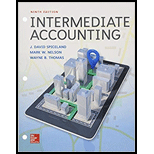
Change in inventory methods
• LO20–2
Fantasy Fashions had used the LIFO method of costing inventories, but at the beginning of 2018 decided to change to the FIFO method. The inventory as reported at the end of 2017 using LIFO would have been $20 million higher using FIFO.
Required:
1. Prepare the
2. In the 2018–2017 comparative income statements, what will be the amounts of net income reported for 2017 and 2018?
3. Prepare the 2018–2017 retained earnings column of the comparative statements of shareholders’ equity.
Trending nowThis is a popular solution!

Chapter 20 Solutions
INTERMEDIATE ACCOUNTING(LL)-W/CONNECT
 Intermediate Accounting: Reporting And AnalysisAccountingISBN:9781337788281Author:James M. Wahlen, Jefferson P. Jones, Donald PagachPublisher:Cengage Learning
Intermediate Accounting: Reporting And AnalysisAccountingISBN:9781337788281Author:James M. Wahlen, Jefferson P. Jones, Donald PagachPublisher:Cengage Learning Cornerstones of Financial AccountingAccountingISBN:9781337690881Author:Jay Rich, Jeff JonesPublisher:Cengage Learning
Cornerstones of Financial AccountingAccountingISBN:9781337690881Author:Jay Rich, Jeff JonesPublisher:Cengage Learning


